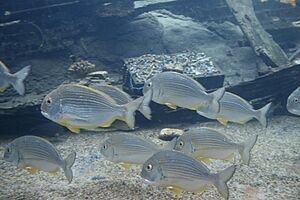Goldlined seabream facts for kids
Quick facts for kids Goldlined seabream |
|
|---|---|
 |
|
| Conservation status | |
| Scientific classification | |
| Synonyms | |
|
The goldlined seabream (Rhabdosargus sarba) is a type of fish found in the ocean. It is also known as the silver bream, tarwhine, or yellowfin bream. This fish belongs to the Sparidae family, which includes other seabreams and porgies. Goldlined seabreams live in a very large area, stretching across the Indo-Pacific region.
Contents
Understanding the Goldlined Seabream's Name
The scientific name for the goldlined seabream is Rhabdosargus sarba. This name was first given to the fish in 1789 by a German scientist named Johann Friedrich Gmelin. He used notes from another scientist, Peter Forsskål.
What Does Rhabdosargus Mean?
The first part of the name, Rhabdosargus, comes from old Greek words. Rhabdos means "stick" or "rod." This might refer to a yellow stripe seen on a similar fish. Sargos was an ancient Greek name for fish in the Sparidae family.
Meaning of Sarba
The second part of the name, sarba, is simpler. It is the Arabic name for this fish in the Red Sea area of Saudi Arabia.
What Does the Goldlined Seabream Look Like?
The goldlined seabream has a body that is deep and flattened from side to side. Its body is about two to two and a half times longer than it is deep. The fish has a fairly large head.
The top part of its body, from its snout to its back fin, is curved. Its eyes are a medium size, but they look smaller on older, larger fish.
Fins and Teeth
The fin on its back, called the dorsal fin, has 11 sharp spines and 12 or 13 soft rays. The fin on its belly, called the anal fin, has 3 spines and 11 soft rays. The fish has strong, flat teeth at the back of its mouth, similar to human molars.
Colors and Size
The goldlined seabream is mostly grayish with a shiny, golden-silver color. Its belly is silvery-white. It has thin, yellowish or golden stripes running along its sides. The fins on its belly and under its tail are yellowish to brownish-yellow.
This fish can grow up to 80 centimeters (about 31 inches) long. However, most goldlined seabreams are about 45 centimeters (about 18 inches) long. The heaviest one ever recorded weighed about 12 kilograms (about 26 pounds).
Where Goldlined Seabreams Live and Their Home
Goldlined seabreams are found in a huge area called the Indo-Pacific. This stretches from the Red Sea and the eastern coast of Africa, all the way to Japan and Australia.
Specific Locations
- They live along the coast of Western Australia, from Bremer Bay to Exmouth.
- On the east coast of Australia, they are found from Townsville, Queensland, down to Mallacoota, Victoria.
- Sometimes, a single goldlined seabream has been seen in the Mediterranean Sea near Syria. Scientists think it might have traveled there from the Red Sea through the Suez Canal.
Their Habitat
These fish live in waters from the surface down to about 60 meters (about 200 feet) deep. Young goldlined seabreams often live in estuaries, which are areas where rivers meet the sea. As they grow older, they move out to deeper coastal waters.
Goldlined Seabream Biology and Life Cycle
Goldlined seabreams mostly eat small creatures that live on the ocean floor, especially molluscs like snails and clams.
Reproduction and Gender Change
Interestingly, goldlined seabreams can sometimes change their gender. In places like South Africa, Hong Kong, and the Persian Gulf, they are often born male and later become female. This is called being a protandrous hermaphrodite.
However, recent studies in Australia show that some goldlined seabreams there might not change gender in the same way. These differences in how they reproduce could mean that there are actually different types of goldlined seabreams, not just one species.
Maturity and Spawning
- Off South Africa, these fish become ready to reproduce when they are about 26 centimeters (about 10 inches) long.
- In Western Australia, they reach maturity when they are between 15 and 21 centimeters (about 6 to 8 inches) long.
- Spawning, which is when fish release their eggs and sperm, happens between July and November. In South Africa, it occurs in shallow waters near large estuaries. In Western Australia, they also spawn during these months, releasing eggs in batches.
- Goldlined seabreams often move to deeper, offshore waters to spawn.
Fishing for Goldlined Seabreams
The goldlined seabream is a popular fish for people who enjoy recreational fishing in Australia. While it's not a huge commercial catch in southwestern Australia, it's important for local fishers in South Africa and Mozambique.
Conservation Status
Sadly, the goldlined seabream has been overfished in the Persian Gulf. Because of this, the International Union for Conservation of Nature (IUCN) has listed it as "Near Threatened" in that area. This means it could become endangered if fishing continues at the same rate. However, globally, the species is considered "Least Concern", meaning it's not currently at high risk.



